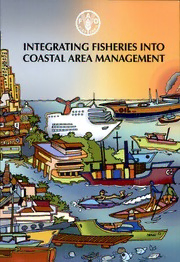Table Of ContentINTEGRATING FISHERIES INTO
COASTAL AREA MANAGEMENT
CoverillustrationbyEmanuelaDAntoni
Copyrightedmaterial
INTEGRATING FISHERIES INTO
COASTAL AREA MANAGEMENT
FOODANDAGRICULTUREORGANIZATIONOFTHEUNITEDNATIONS
Rome,2008
Thedesignationsemployedandthepresentationofmaterialinthisinformation
productdonotimplytheexpressionofanyopinionwhatsoeveronthepart
oftheFoodandAgricultureOrganizationoftheUnitedNations(FAO)concerningthe
legalordevelopmentstatusofanycountry,territory,cityorareaorofitsauthorities,
orconcerningthedelimitationofitsfrontiersorboundaries.Thementionofspecific
companiesorproductsofmanufacturers,whetherornotthesehavebeenpatented,does
notimplythatthesehavebeenendorsedorrecommendedbyFAOinpreferenceto
othersofasimilarnaturethatarenotmentioned.
ISBN978-92-5-105968-5
Allrightsreserved.Reproductionanddisseminationofmaterialinthisinformation
productforeducationalorothernon-commercialpurposesareauthorizedwithout
anypriorwrittenpermissionfromthecopyrightholdersprovidedthesourceisfully
acknowledged.Reproductionofmaterialinthisinformationproductforresaleorother
commercialpurposesisprohibitedwithoutwrittenpermissionofthecopyrightholders.
Applicationsforsuchpermissionshouldbeaddressedto:
Chief
ElectronicPublishingPolicyandSupportBranch
CommunicationDivision
FAO
VialedelleTermediCaracalla,00153Rome,Italy
orbye-mailto:
[email protected]
©FAO2008
Copyrightedmaterial
1
Integratingfisheriesintocoastalareamanagement
Marine and large lake fisheries depend on the coastal
areainmanydifferentways.Afishery’ssuccessisbasedupon
continuingstocksoffish,whichrequirehealthyhabitatsfortheir
own food supplies and life cycles. Activities that result in
changestoacoastalenvironmentcanaffectthelong-termwell
beingoffisheries. Likewise,fishingactivitiesmayimpactother
coastalinterestsandactivities,suchasagricultureandtourism,
whichalsorequirespaceandresources.
Coastal developments should be well planned and
managedwithcare,toavoidfocusingtoomuchonanysingle
activity. Countries should protect their natural resources,
keepinginmindtheinterestsofallpeopleliving inthecoastal
area. This comprehensive or “holistic” approach is known as
integratedcoastalmanagement(ICM).
ICMcouldbecomparedtothebuildingofahouse,which
is used for a variety of activities - often by a number of
residents. Manyconsiderationsareinvolved, including building
location,characteristicsoffutureoccupants,materialsavailable,
and cost. Before construction begins, an overall planning
frameworkisprepared,toidentifyneedsandtoguidethework.
TheseguidelinesexplainandexpanduponArticle 10of
the 1995 Code of Conduct for Responsible Fisheries, more
commonlyknownastheCodeofConduct.Article10considers
howfisheriescanbeincludedinplanningandmanagingcoastal
areasandresources.
Copyrightedmaterial
2
ICMframework
Toconserve natural resourcesand include residents in
decisions about their use, countries should establish
appropriatepolicy,legalandinstitutionalplans.
Generalcoastaldevelopments
Apolicyframeworkestablishestherangeofgovernment
policies that will permit development, conserve the coastal
environment,andaccommodatethesocialandeconomicneeds
oflocalpeople.Land,water,airqualityandpeople’slivelihoods
should be considered and protected. Since development
projects and growing populations are threats to natural
resources,thechallengeliesindecidinghowscarceresources
shouldbeallocated.
A major policy problem in managing coastal areas
involves“freeand openaccess”to resources. Forexample, if
mangroves, coral reefs and the open ocean can be used
withoutrestrictions, consequenceslikewaterpollutionandthe
destruction offish habitats maythreaten thewell-being ofthe
whole area. It is important that “free and open access” to
coastal resources be replaced with a policythat controls and
regulatesaccesstoandtheuseoftheseresources.
Alegalframeworkputscoastalmanagementinstitutions
andtheactionsundertakenbythemintolaw.Resourceusecan
becontrolledbylawsthatregulate,banorlimitcertainactivities.
Withinafishery,controlsmightbeplacedoverfishinggearand
practices,aswellasonthearea,seasonandtimeoffishing.If
theregulationsarenotfollowed, penaltiesshould beimposed.
Copyrightedmater
3
Aproblemwiththis“regulatory”approachisenforcement.Ifitis
notpossibletoenforceaparticularregulation, itmaybebetter
to not introduce it. Regulations should be flexible enough to
deal with a range of possible situations and to help those
peopleinvolvedunderstandtheirobligations.
Another approach to managing resources is the
“economic” approach, which offers financial incentives or
requires groups to payfortheiractivities through mechanism
suchasuserfees, chargesforreleasing industrialwaste, etc.
Even if this policy can be only partly implemented, it often
increasestheflexibilityofthemanagementsystem(e.g.itmay
beeasiertorevisechargesfordifferentusersthantochange
regulationsaffectingthem).
Governmentsshouldbeclearaboutwhattheyaretrying
to achieve with a legal framework, and examine a range of
possiblesolutions.Theyshouldunderstandthatcircumstances
canvary,andthe“bestsolution”maychangeovertime.
An institutional framework brings together national,
regional and local authorities involved incoastal planningand
clearlydefinestheirresponsibilities.Itisimportantthatnosingle
developmentactivityisgivenanunfairadvantage.Thereshould
bearesponsibleagencyforimportantissues,withmeasuresin
place to coordinate the activities of all agencies. A truly
integrated approach has responsibility for planning and
allocatingresourcesunderasingleinstitution.Thisensuresthat
authoritiesatalllevelsworktogetherandarekeptinformedof
coastalareapoliciesastheyarecreatedandputintopractice.
Fisherydevelopments
Sometimes the rights of traditional fishers and fish
farmersto use coastal resources are overlooked in favourof
othergroupssuchasagricultureortourism.Thefishingsector
isespecially susceptible to environmental damagefrom other
activitiesinthearea.Examplesinclude:
Copyrightedmaterial
4
Pollution: e.g. industrial or agricultural waste,
pesticidesandfertilizers,sewage,oilspills.
Habitat degradation: e.g. mangrove clearance, coal
mining,soilrunoffsintoseagrassbedsandreefs.
Spatial conflicts: where fisheries are squeezed out
fromtraditionalareasbyothercoastaldevelopments.
Fishersmustberecognizedasmajorstakeholders,with
their representatives included in general coastal management
planning. Authorities should have a role in environmental
impactstudies, issuingconstruction permits, drafting lawsand
regulations,andindecisionsregardingtheuseofcoastalarea
space.
Internal disputes may arise between fishers from
different places using the same area, and between different
kindsoffishermen,especiallywithregardtotheuseofdifferent
fishinggears.Thisisnormallyreferredtoas“gearinteraction”.
Regulations on when and where fishing may be done, or
placing limitations on the use of different gears in different
areas or at different times, are examples ofways to resolve
internal disputes. These regulatory measures should be
developedandimplementedinconsultationwiththefishers.
If potential conflicts within fisheries and between them
andothergroupsusingthemarineenvironmentareanticipated,
some conflicts may be avoided. The important thing is that
fisheries and coastal area management authorities work
cooperativelytoidentifyandresolveconflictsquicklyandfairly.
Policymeasures
Once a framework for ICM has been established, the
principles should be incorporated into national policies for
managing coastal areas. This section describes key tasks
whichshouldbeundertakenintheprocess.
Copyrightedmaterial
5
Informandinvolvethepublic
Allgroupsusingcoastalresourcesshouldbeincludedin
makingdecisionsaboutthem.Thisiscalleda“participatoryor
inclusive”approachtodecision-making.Ifthepublic,especially
localresidentsofcoastalcommunities,haveaninformedsayin
howtheirareaistobedeveloped,goodplanningdecisionsand
compliance with subsequent laws are more likely to result.
Ways of involving and keeping the public informed include
creating discussion groups, holding publicmeetings, usingthe
media and getting non-governmental organizations (NGOs)
involved.
However, the natureoffishing activities, whereworking
hours can be long and irregular and fishing communities
isolated maymake itdifficultto reach fishers, thereby placing
thematadisadvantagecomparedtoothercoastalusers.This
disadvantage may be reduced if fisher’s organizations are
establishedandlegallyassuredavoiceinthedecision-making
process.
Putvaluesontheresources
Coastalresourcescanbe“valued"relativetothebenefits
ofaproposedactivity. Determiningwhichhasmorevalue-the
resource or the activity - can be a factor in deciding how
resources should be allocated. Social, cultural and economic
usesshouldbeconsideredandvalued.Thefactthataresource
doesnothavea“marketprice”(i.e.isnotsold),doesnotmean
itlacksvalue.Thevalueofcleanairtotheentirecommunity,in
Copyrightedmaterial
6
relationtotheeconomiccostsofabadlypolluting industry, is
one example. Or, consider a development project such as a
proposed shrimp pond, which would destroy an area of
mangrove.Thevalueinthemangrove’snaturalroleofproviding
afish habitatand protectingtheshorelineagainststormsand
cyclones should not be ignored when considering potential
costsandbenefitsoftheshrimpfarm.
Considerrisksanduncertainties
Managementpoliciesshould reflectarangeofpossible
outcomes from proposed development projects. Fishery
authorities should identify potential threats and ensure that
precautionsaretakentoprotectfisheries’interests.Prevention
isbest,butifdamageisunavoidable,stepsshouldbetakento
minimizeit,compensatestakeholdersandrehabilitatethearea.
Theterm“risk”isoftenusedwhentheexacteffectsofa
proposed activity are unknown, but the likelihood ofdifferent
outcomes can be determined with the information at hand.
Insurancemaybeavailableforsomeriskssuchasdamageby
an oil spill to a coastal reef or near-shore fishery. To be
effective, risk management policies must be supported by a
legal framework identifying responsibility and penalties, while
recognizingthatsomeeventssimplycannotbeanticipated.
Ontheotherhand,whenthereisnotenoughinformation
to know the likelihood of certain outcomes, the term
“uncertainty” isused. Forexample, the impacton afisheryof
flood water from a storm is uncertain and is not normally
covered by insurance. It is best to avoid activities where
outcomes are totally uncertain or may cause irreversible
environmentaldamage.
Monitortheenvironment
With damage prevention in mind, it is important to
identify potential effects ofdevelopment activities as early as
Copyrightedmaterial

